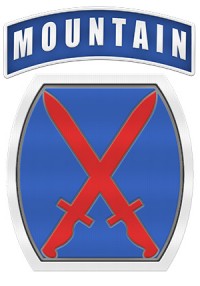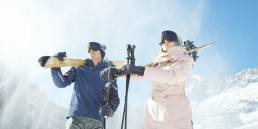WAR & SKIING – The 10th Mountain Division
THERE NEVER WAS A GROUP OF FIGHTING MEN QUITE LIKE THE 10TH MOUNTAIN DIVISION
They were present at the creation of Aspen and Vail. Without them there would be no Arapahoe Basin in Colorado, no Crystal Mountain in Washington, no Sandia Peak in New Mexico, no Sugarbush in Vermont, no Mount Bachelor in Oregon. Alta in Utah would be a different place entirely without them. The same applies to the Olympic Village in St. Moritz in 1948. Five of them were on the United States ski team in the 1948 Olympics, six if you include the coach.
“All of the guys in the 10th Mountain Division had one thing in common. We loved the mountains.”
 Footprints in the snow are notoriously short lived — new snowfall covers them up; they become smudged by time, they are eroded by thaws and disappear with the changing of the seasons. But the footprints the men of the 10th Mountain Division are left where they trained in the snows of Colorado, where they fought in wartime Europe, and across North America, where they planted more than five dozen ski resorts, defying the physics of snow. They endure and, in a further defiance of the natural world, they glimmer, if not actually on the mountainsides, then surely in the legacy they provided.
Footprints in the snow are notoriously short lived — new snowfall covers them up; they become smudged by time, they are eroded by thaws and disappear with the changing of the seasons. But the footprints the men of the 10th Mountain Division are left where they trained in the snows of Colorado, where they fought in wartime Europe, and across North America, where they planted more than five dozen ski resorts, defying the physics of snow. They endure and, in a further defiance of the natural world, they glimmer, if not actually on the mountainsides, then surely in the legacy they provided.
Because there never was a group of fighting men — there never was a group of ski pioneers — there never was a group of snow-crazy warriors, partiers, visionaries, and men of destiny — quite like the men of the 10th Mountain Division. They helped defeat tyranny, they helped establish an important industry, and they helped define an era that grows more glorious with the years.
 “All of the guys in the 10th Mountain Division had one thing in common,’’ says Richard Calvert of Wolfeboro, New Hampshire, who is still skiing at age 91. “We loved the mountains. We were hunters, we were fishermen, we were climbers and of course we were skiers. And when we came back we continued to hunt and to fish — and to ski.“For me,’’ he continues, “it was the most important experience of my life.’’
“All of the guys in the 10th Mountain Division had one thing in common,’’ says Richard Calvert of Wolfeboro, New Hampshire, who is still skiing at age 91. “We loved the mountains. We were hunters, we were fishermen, we were climbers and of course we were skiers. And when we came back we continued to hunt and to fish — and to ski.“For me,’’ he continues, “it was the most important experience of my life.’’
It was, for all of them, a defining experience. One of them became the president of the Sierra Club and founded Friends of the Earth. One co-founded Nike, one coached the San Diego Chargers. One was the governor of Massachusetts, one — not a skier but whose life was saved by two skiers — was a flatlander from a Dust Bowl town. He was Robert Joseph Dole of Russell, Kansas, where no one he ever knew in his hard scrabble plains home town had ever seen, let alone put on, a pair of skis. Dragged to safety in the mountains by two skiing comrades, he survived to become the Senate majority leader and the 1996 Republican presidential nominee.
“I can say without reservation that if those two skiers hadn’t been with me I would have never made it,’’ Dole told me. “I would not have survived.’’
In our mind’s memory, skiing is a sport of tranquility and serenity, performed in a remote mountain fastness; the wind and the glancing sweep of skis against snow are the only sounds, and if audible at all, those are whispers, not shouts. Whether amid the trees in the West or on finely sculpted cruising trails in the East, skiing at its artful best is a matter of swishes and swooshes, rustles and murmurs.
A DIVISION OF SKI WARRIORS WHOSE HIGH-ALTITUDE AGILITY AND SKIING PROWESS COULD PROVIDE PROTECTION ALONG AMERICA’S NORTHERN BOUNDARIES
That’s the reverie. The reality is different. For a millennium, these implements of recreation have had the capacity to help wreak military damage, perform acts of sabotage, and stage lethal forest ambushes in various isolated episodes of history. Our weekend warriors on the slopes of Killington have their analogues and ancestors in the killing fields of Asia and Europe — and records show that skis were prominent in warfare as early as the Battle of Oslo in the year 1200.
Yet it was the Finns who shaped winter warfare, as we know it. On silent skis they moved along remote trails to resist the Soviets in the Winter War of 1939-1940, oftentimes in temperatures so forbidding that, in one of the curiosities of cold, the Fahrenheit and Celsius scales merged at minus 40 degrees. In evocative photographs of the time, the Finnish soldiers, outfitted in white, are portrayed burrowed in snow banks, their rifles at hand but their skis and poles discarded at the side.
 These troops, known to the frustrated Russians as “White Death,’’ caught the Soviet invaders off guard with forest ambushes that, as the Times of London put it, made “rings around Russian soldiers” — and inspired the world. They also attracted the attention of a fabled Dartmouth skier named Dave Bradley, who would later design more than five-dozen ski-jump hills and win international attention for his work for peace in a nuclear world.
These troops, known to the frustrated Russians as “White Death,’’ caught the Soviet invaders off guard with forest ambushes that, as the Times of London put it, made “rings around Russian soldiers” — and inspired the world. They also attracted the attention of a fabled Dartmouth skier named Dave Bradley, who would later design more than five-dozen ski-jump hills and win international attention for his work for peace in a nuclear world.
Dave Bradley — writer, surgeon, Olympic team manager, New Hampshire state legislator — had seen the Finnish resistance firsthand, and he conveyed this report to Charles Minot (Minnie) Dole, the founder and, for more than a dozen years the director, of the National Ski Patrol:
“The Finnish skiers were their own armies, their own general staffs, and many is the boy who tackled and downed a tank with no more weapon than a log of wood or a gasoline bottle tied to a hand grenade.’’
That sentence and a hearthside conversation involving Minnie Dole and three other ski pioneers in a Vermont retreat provided the strategic seeds of the 10th Mountain Division. There had been American ski soldiers before; in 1898 Frederick Remington captured on film the activities of U.S. Army ski patrols in Yellowstone. But what these men conjured in front of a roaring fire 3,750 miles from Hitler’s Berlin bunker would change the nature of American warfare and lead to a vital World War II victory in the northern Apennine Mountains of Italy.
 And so the call went out for mountain men and for men merely familiar with the mountains, the goal being the creation of a division of ski warriors whose high-altitude agility and skiing prowess could provide protection along America’s northern boundaries, or wage guerrilla warfare in the high altitudes of Europe, or conduct conventional attacks along mountain
And so the call went out for mountain men and for men merely familiar with the mountains, the goal being the creation of a division of ski warriors whose high-altitude agility and skiing prowess could provide protection along America’s northern boundaries, or wage guerrilla warfare in the high altitudes of Europe, or conduct conventional attacks along mountain
frontiers. The idea was fanciful, it was romantic, it was exciting — and it was dangerous. The foes would be Axis forces, to be sure, but the foes would also be the weather (unpredictable, but leaning toward terrible in the mountains) and the terrain (the most dangerous in the world).
“When it came time to get drafted I joined the 10th and skiing was the reason,’’ says Don Linscott, who grew up barreling down the Thunderbolt Trail on Mount Greylock, constructed by the Civilian Conservation Corps and site of the 1936 United States Eastern Alpine Ski Championships. I caught up with him — one of 19 young men who joined the 10th from his tiny hometown of Adams, Mass. — just before he went skiing at age 91 last winter at Pat’s Peak in Henniker, New Hampshire. “I figured that if you were going to go into the Army anyway you might as well join the mountain troops. It was perfect for me.’’
Bradley suggested the ski troops recruit his onetime Dartmouth coach Walter Prager, a Swiss émigré originally drafted into the Coast Guard even though he did not know how to swim. Before long he was First Sergeant Prager and was assigned to the mountain troops, in part because along with being a ski evangelist he was at heart a practical man. In a $1.50 how-to book about skiing written in 1939, the man who would later become the coach of the 1948 United States Olympic ski team opened Chapter Four with this sentence: “If you can walk, climb, and regain your feet after a spill, you are ready for downhill skiing.’’
“I CAN SAY WITHOUT RESERVATION THAT IF THOSE TWO SKIIERS HADN’T BEEN WITH ME I WOULD HAVE NEVER MADE IT,” BOB DOLE TOLD ME. ” I WOULD NOT HAVE SURVIVED.”
 It was slightly more complicated than that, of course, and as a result the core of the corps was Prager’s Dartmouth skiers, who accounted for 107 of the 10th’s men. “There is little use wasting all the time and energy teaching a bunch of southerners how to ski,’’ Bradley said.
It was slightly more complicated than that, of course, and as a result the core of the corps was Prager’s Dartmouth skiers, who accounted for 107 of the 10th’s men. “There is little use wasting all the time and energy teaching a bunch of southerners how to ski,’’ Bradley said.
The training was rigorous and remote at Camp Hale, 9,500 feet above sea level near Pando, Colo. There the men were drilled in mountaineering, skiing, snow shoeing, and then were taught how to construct snow caves and employ dog sleds. One picture produced by Winston Pote, who would later attain fame for his photographs of skiing in New Hampshire’s White Mountains, showed the mountain troops marching in formation with skis rather than rifles balanced on their shoulders.
The 10th was an object of irresistible and unremitting interest, stoked by the military publicity machine. Crews from Columbia Pictures and Warner Brothers mobilized. LIFE magazine put the mountain troops on its cover. The film Mountain Fighters opened with an NFL Films-style narrator who bellowed with a stentorian reverence that would later be applied to the Mercury Seven astronauts:
“Here, surrounded by the awe-inspiring grandeur of towering snow-clad peaks, our mountain divisions are being trained for the vital role they will play in the destruction of the Axis. And what men they are!’’
What men they were. Their greatest moment came in February 1945, on the Riva Ridge escarpment, so steep that, according to Jeffrey R. Leich’s account in his Tales of the 10th, published in 2003, “the German mountain troops holding it believed it was unclimbable.’’ On four separate routes the men of the division made their daring ascent, scattering the German soldiers, some of whom may well have been members of the German Universities Ski Team that members of the mountain troops had faced in ski competition on the very Thunderbolt Trail that Don Linscott had bolted down as a boy.
“It cannot be ruled out,’’ Charles J. Sanders wrote in The Boys of Winter, his 2005 chronicle of the men of the 10th “that some had met their enemy before in the mountains.’’
Their training — so steeped in mythology and romance that Robert Redford has optioned Peter Shelton’s 2003 Climb to Conquer for a film — changed history. The nighttime assault on the ice and snow of Riva Ridge is regarded as an indispensable part of the combat along the spine of the Apennines in Italy. Riva Ridge lent its name to one of the original trails at Vail, a beloved four-mile journey with stunning views and challenging steeps. And Apennine combat resulted in the transformation of one of the most remarkable men in modern American politics.
He is known to history as one of the greatest legislators ever to serve in the Senate. But before he moved into politics, Bob Dole — once a high school basketball star renowned for his two-hand set shot and later an advocate for the disabled — was blown apart by a shell on the side of an Italian mountain while leading his troops in the last months of the war, injured so badly that a platoon sergeant gave him a shot of morphine but didn’t think he would survive. He almost didn’t.
“We had two ski guys with us,’’ Dole, then 92, told me last winter. “I was no mountain guy, but they were. They dragged me to safety, and then they stayed with me far too long, or at least longer than they probably should have.’’
 Dole was so profoundly injured that his weight dropped to 122 pounds. One day his temperature spiked to 107.8 degrees. He lost his right kidney. He was hospitalized for four years. At his very depths, Dole was a symbol of the hardship the mountain troops endured — hardships shared even by those who returned fit enough to ski and go on to found scores of mountain resorts in the peacetime primes of their lives.
Dole was so profoundly injured that his weight dropped to 122 pounds. One day his temperature spiked to 107.8 degrees. He lost his right kidney. He was hospitalized for four years. At his very depths, Dole was a symbol of the hardship the mountain troops endured — hardships shared even by those who returned fit enough to ski and go on to found scores of mountain resorts in the peacetime primes of their lives.
“I wanted to be in the ski troops, but when you get into a combat outfit you don’t realize that it is not glamorous,’’ Newc Eldredge, a onetime Dartmouth skier who still occasionally strapped on his skis at age 90, told me before he died in early July. “There is a lot of darkness to it. It is not a pleasure. We experienced a lot of combat, and I hadn’t anticipated that. It was devastating.’’
After the war a new, quieter battle began — to restore and enhance a ski business that had been hindered by gas rationing and wartime privations, and perhaps even to tame it.
“These were the men who came back from the war and continued to live that life,’’ says Bob Linscott, president of the New England chapter of the National Association of the 10th Mountain Division and the son of one of the winter warriors. “They wanted the outdoor ethic to survive, and they wanted to expose as many people as possible to the ski life. They literally made a new industry.’’
One of those pioneers was Pete Siebert, injured in Apennine combat so badly that his rehabilitation took 17 months. With grit and a homemade leg brace, he became a ski instructor at Aspen and operations manager at Loveland. But like so many in the 10th, he was a dreamer, too, and his vision transformed a Colorado sheep pasture into a resort known as Vail and then sowed the seeds of Snow Basin, the Utah ski behemoth that later was host to the 2002 Olympic ski events and was the setting for the movie Frozen.
Siebert and his companions from the 10th provided the impetus and the inspiration for the new ski industry, leaving their fingerprints on more than 60 ski areas beyond Vail and Snow basin. They were helped by the piles of surplus ski equipment, all originally intended for the mountain soldiers, but were perfectly serviceable on trails on the sides of White Pass in Washington State, Ski Santa Fe in New Mexico, and Jackson Hole in Wyoming, which the men of the 10th would sculpt.
And so the story of skiing in wartime is really a tale of triumph in peacetime. The soldiers who towed their materials with ropes constructed rudimentary rope tows. The men who carried guns in mountain side battles soon set up ski guns on state side slopes. They traded military bases for base lodges. They built more than just T-bars, Poma lifts, and chairlifts. They built lives in the mountains — and their legacy is a mountain way of life that has endured, a sparkling vision in white, for three generations.




